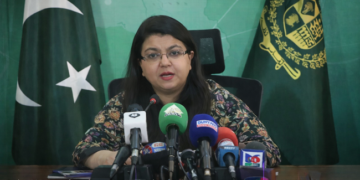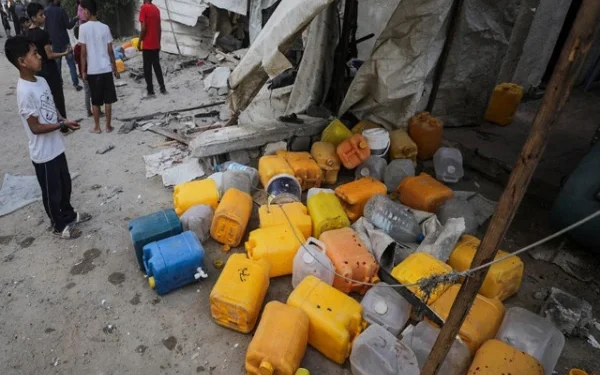Introduction: Tragedy Unfolds in Gaza Amid Escalating Violence
Gaza continues to suffer under relentless Israeli military bombardment, as the humanitarian crisis deepens to unprecedented levels. In one of the latest and most heart-wrenching incidents, an Israeli missile struck a water distribution center in the central Nusrat refugee camp, killing at least 10 Palestinian children who were lined up to collect drinking water. Medical officials on the ground also confirmed that 17 others were wounded in the same attack. The continued military operations have not only exacerbated the destruction but have also made access to basic human necessities such as water and medical care extremely dangerous and scarce.
This devastating assault comes amid ongoing Israeli airstrikes that have reportedly killed at least 95 Palestinians in total, including 17 people in a Gaza City market, according to the Gulf News Agency and the Palestinian Health Ministry.
The Targeting of Essential Civilian Infrastructure
Water Distribution Center Attack in Nusrat Camp
According to local medical sources and humanitarian agencies, the children killed in the missile strike were innocently standing in line to fetch drinking water—one of the few lifelines left amid Gaza’s water crisis. The water distribution point in the Nusrat refugee camp, located in the central Gaza Strip, was targeted without prior warning. Witnesses described scenes of panic and chaos as bodies were pulled from rubble and wounded children cried out for help.
The Israeli military, in response to inquiries, stated that the missile strike was intended to target a Palestinian militant. The military further claimed that a technical malfunction caused the missile to miss its intended target. However, this explanation has not been independently verified, and no official evidence has been provided to support the claim.
Market Bombing in Gaza City: A Renowned Doctor Among the Victims
In another deadly strike, Israeli warplanes targeted a bustling market in Gaza City, resulting in 17 more fatalities, including Dr. Ahmed Qandil, a prominent and widely respected physician. Dr. Qandil had been providing emergency medical care to displaced and injured Palestinians in makeshift hospitals and shelters.
Civilians had gathered in the market hoping to procure food, despite severe shortages, when the bombing occurred. Eyewitnesses said the market was crowded, and the attack struck during peak hours, causing mass casualties and panic. The Israeli military did not issue any comments specifically regarding this market strike.
Mounting Death Toll and Humanitarian Crisis
Casualties and Injuries
According to the Palestinian Health Ministry, the total number of Palestinians killed since the beginning of the current Israeli military campaign has surpassed 58,000, a staggering figure that highlights the scale of destruction and death. Of these, over half are women and children, indicating the disproportionately high civilian death toll.
The ministry also confirmed that at least 138,500 Palestinians have been injured, many of whom have sustained life-altering disabilities due to the lack of advanced medical facilities in the besieged territory.
Humanitarian Collapse and Famine Risk
The situation in Gaza has now deteriorated to the point where 2.1 million people—the majority of the enclave’s population—are at risk of famine. Due to the ongoing Israeli blockade, essential supplies including food, clean water, medicine, and fuel have been cut off or severely restricted. The United Nations Relief and Works Agency for Palestine Refugees (UNRWA) recently confirmed the death of another infant from malnutrition, underscoring the scale of the growing humanitarian emergency.
Hospitals are overwhelmed, and sanitation infrastructure has collapsed. Most water purification and desalination facilities have stopped functioning due to lack of electricity and fuel. In this dire context, water collection points have become vital, albeit dangerous, gathering spots for civilians—making them especially vulnerable to airstrikes.
Repeated Violations of International Humanitarian Law
Attacks on Civilian Infrastructure
Human rights organizations, including Human Rights Watch and Amnesty International, have repeatedly condemned the Israeli military for what they describe as “indiscriminate targeting” and “disproportionate use of force” in Gaza. Under international humanitarian law, deliberate attacks on civilian infrastructure, including water facilities, schools, hospitals, and markets, are considered war crimes if proven intentional or carried out with reckless disregard for civilian life.
The recent attack on the water distribution center, where only unarmed civilians and children were present, may further deepen the call for an independent international investigation into possible war crimes.
Water Crisis in Gaza: A Critical Health Threat
Gaza’s Water Infrastructure Under Siege
Gaza’s water crisis is not new, but it has reached catastrophic levels in recent months due to the continued conflict and siege. More than 97% of Gaza’s groundwater has been deemed unfit for human consumption, and desalination plants—the territory’s primary source of drinkable water—have either been destroyed or are non-operational due to fuel shortages.
According to UNICEF, many families now survive on just two to three liters of water per day, far below the minimum standard recommended for drinking and hygiene.
International Response and Condemnations
Growing Calls for Ceasefire and Humanitarian Aid
The international community has issued a renewed wave of condemnations and urgent calls for ceasefire, particularly after the attacks on the market and water distribution center. The European Union, United Nations, and multiple Middle Eastern countries have demanded that Israel halt its airstrikes and allow unrestricted humanitarian access to Gaza.
However, the United Nations Security Council has failed to reach a binding resolution due to repeated vetoes, especially from the United States, Israel’s key ally. Humanitarian agencies continue to warn that without immediate international intervention, the situation could spiral into a full-scale famine and public health disaster.
Stories from the Ground: Witnesses Speak Out
A Mother’s Anguish
Fatima al-Jabari, whose 8-year-old son was among those killed at the water center, sobbed uncontrollably as she clutched his blood-stained school bag. “He just went to get water. He was thirsty… they bombed him for that,” she said. “There were no fighters there. Just children. Just water.”
Medical Personnel Overwhelmed
Dr. Ayman al-Sheikh, a trauma surgeon at a local clinic in central Gaza, described the scene after the missile strike. “We received so many children. Some had missing limbs, others had burns across their bodies. We did what we could with the little supplies we had,” he said. “But we’re running out of everything—gauze, anesthesia, antibiotics.”
The Broader Conflict: Context and Escalation
Timeline of Escalation
This latest round of violence stems from escalating tensions that began months ago, including clashes at Al-Aqsa Mosque and expanding Israeli settlement activities in the West Bank. The conflict intensified after a series of cross-border exchanges and mutual retaliatory strikes.
Since then, Israeli airstrikes have intensified, focusing on densely populated civilian areas in Gaza, while Hamas and other Palestinian factions have launched rockets into Israeli territory. While Israel claims its actions are defensive, critics argue that the scale and frequency of attacks reflect a strategy of collective punishment.
Conclusion: Urgent Need for Peace and Accountability
The bombing of a water collection point in Gaza, resulting in the deaths of 10 innocent children, underscores the unbearable human cost of war and occupation. With over 58,000 Palestinians dead, most of them civilians, the international community is being pushed to take more decisive action. The calls for an immediate ceasefire, unrestricted humanitarian access, and accountability for violations of international law are now more urgent than ever.
Without global intervention, Gaza may face not only further death and destruction but a generational trauma that will haunt its people for decades to come.

























